The NVIDIA GeForce GTX Titan X Review
by Ryan Smith on March 17, 2015 3:00 PM ESTCompute
Shifting gears, we have our look at compute performance.
As we outlined earlier, GTX Titan X is not the same kind of compute powerhouse that the original GTX Titan was. Make no mistake, at single precision (FP32) compute tasks it is still a very potent card, which for consumer level workloads is generally all that will matter. But for pro-level double precision (FP64) workloads the new Titan lacks the high FP64 performance of the old one.
Starting us off for our look at compute is LuxMark3.0, the latest version of the official benchmark of LuxRender 2.0. LuxRender’s GPU-accelerated rendering mode is an OpenCL based ray tracer that forms a part of the larger LuxRender suite. Ray tracing has become a stronghold for GPUs in recent years as ray tracing maps well to GPU pipelines, allowing artists to render scenes much more quickly than with CPUs alone.
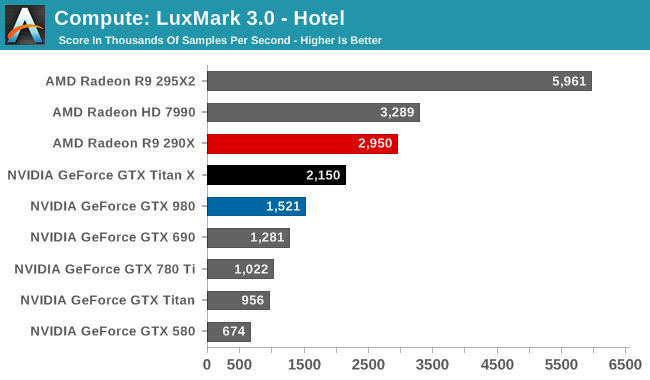
While in LuxMark 2.0 AMD and NVIDIA were fairly close post-Maxwell, the recently released LuxMark 3.0 finds NVIDIA trailing AMD once more. While GTX Titan X sees a better than average 41% performance increase over the GTX 980 (owing to its ability to stay at its max boost clock on this benchmark) it’s not enough to dethrone the Radeon R9 290X. Even though GTX Titan X packs a lot of performance on paper, and can more than deliver it in graphics workloads, as we can see compute workloads are still highly variable.
For our second set of compute benchmarks we have CompuBench 1.5, the successor to CLBenchmark. CompuBench offers a wide array of different practical compute workloads, and we’ve decided to focus on face detection, optical flow modeling, and particle simulations.
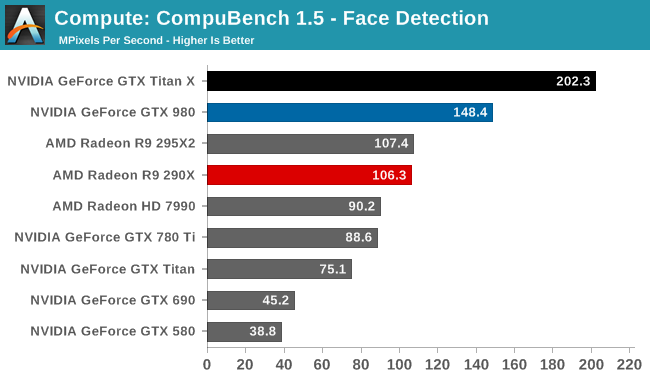
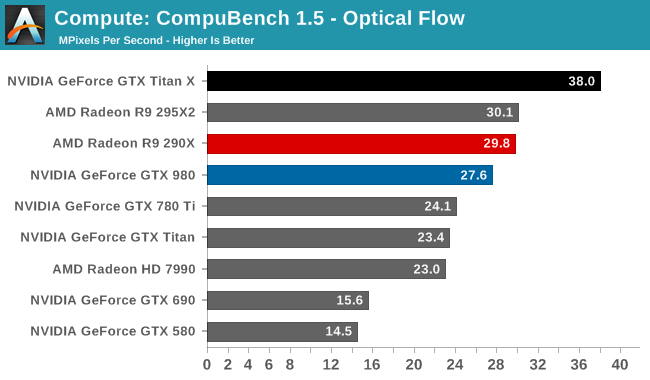
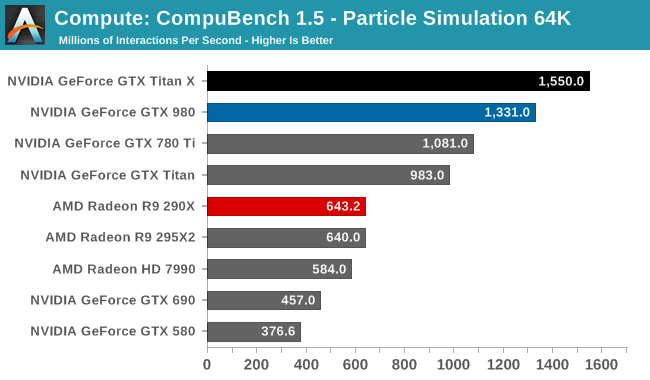
Although GTX Titan X struggled at LuxMark, the same cannot be said for CompuBench. Though the lead varies with the specific sub-benchmark, in every case the latest Titan comes out on top. Face detection in particular shows some massive gains, with GTX Titan X more than doubling the GK110 based GTX 780 Ti's performance.
Our 3rd compute benchmark is Sony Vegas Pro 13, an OpenGL and OpenCL video editing and authoring package. Vegas can use GPUs in a few different ways, the primary uses being to accelerate the video effects and compositing process itself, and in the video encoding step. With video encoding being increasingly offloaded to dedicated DSPs these days we’re focusing on the editing and compositing process, rendering to a low CPU overhead format (XDCAM EX). This specific test comes from Sony, and measures how long it takes to render a video.

Traditionally a benchmark that favors AMD, GTX Titan X closes the gap some. But it's still not enough to surpass the R9 290X.
Moving on, our 4th compute benchmark is FAHBench, the official Folding @ Home benchmark. Folding @ Home is the popular Stanford-backed research and distributed computing initiative that has work distributed to millions of volunteer computers over the internet, each of which is responsible for a tiny slice of a protein folding simulation. FAHBench can test both single precision and double precision floating point performance, with single precision being the most useful metric for most consumer cards due to their low double precision performance. Each precision has two modes, explicit and implicit, the difference being whether water atoms are included in the simulation, which adds quite a bit of work and overhead. This is another OpenCL test, utilizing the OpenCL path for FAHCore 17.
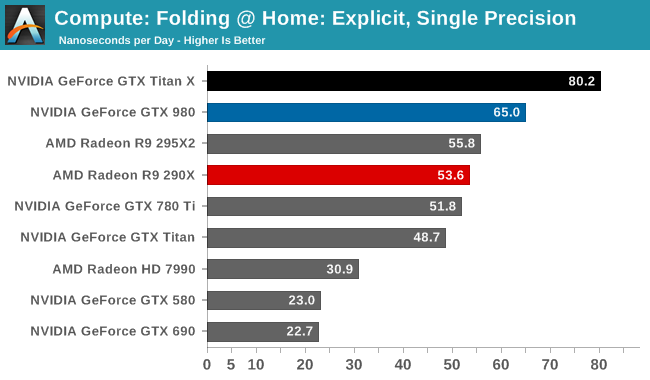
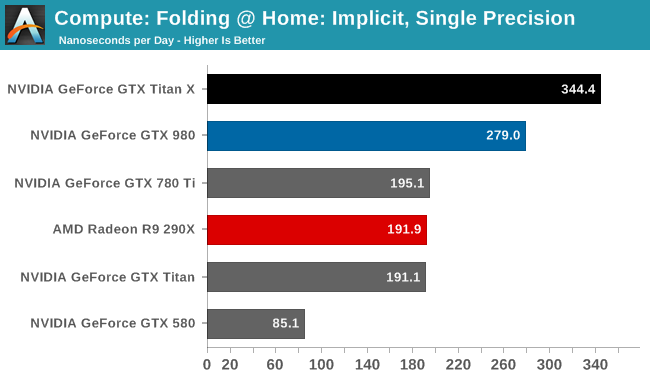
Folding @ Home’s single precision tests reiterate just how powerful GTX Titan X can be at FP32 workloads, even if it’s ostensibly a graphics GPU. With a 50-75% lead over the GTX 780 Ti, the GTX Titan X showcases some of the remarkable efficiency improvements that the Maxwell GPU architecture can offer in compute scenarios, and in the process shoots well past the AMD Radeon cards.
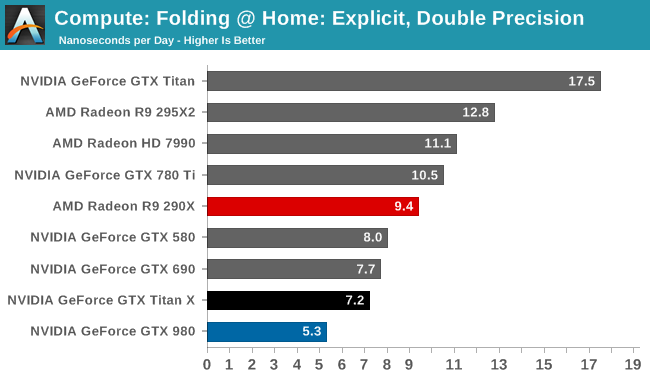
On the other hand with a native FP64 rate of 1/32, the GTX Titan X flounders at double precision. There is no better example of just how much the GTX Titan X and the original GTX Titan differ in their FP64 capabilities than this graph; the GTX Titan X can’t beat the GTX 580, never mind the chart-topping original GTX Titan. FP64 users looking for an entry level FP64 card would be well advised to stick with the GTX Titan Black for now. The new Titan is not the prosumer compute card that was the old Titan.
Wrapping things up, our final compute benchmark is an in-house project developed by our very own Dr. Ian Cutress. SystemCompute is our first C++ AMP benchmark, utilizing Microsoft’s simple C++ extensions to allow the easy use of GPU computing in C++ programs. SystemCompute in turn is a collection of benchmarks for several different fundamental compute algorithms, with the final score represented in points. DirectCompute is the compute backend for C++ AMP on Windows, so this forms our other DirectCompute test.
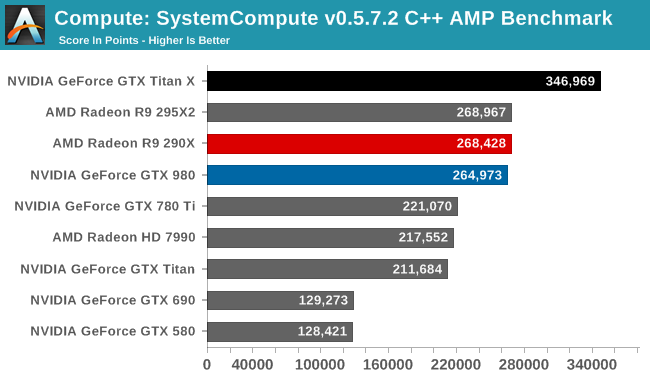
With the GTX 980 already performing well here, the GTX Titan X takes it home, improving on the GTX 980 by 31%. Whereas GTX 980 could only hold even with the Radeon R9 290X, the GTX Titan X takes a clear lead.
Overall then the new GTX Titan X can still be a force to be reckoned with in compute scenarios, but only when the workloads are FP32. Users accustomed to the original GTX Titan’s FP64 performance on the other hand will find that this is a very different card, one that doesn’t live up to the same standards.










276 Comments
View All Comments
D. Lister - Tuesday, March 17, 2015 - link
@packermanSo all I saw was that AMD was wiping the floor with it for 300 dollars less. Am I missing something.
While I agree with the new Nvidia card being overpriced, ultimately one cannot disregard the facts that the 295x2,
- is Dual GPU, so its added performance is tied to a crossfire profile.
- consumes nearly twice the power under load, inevitably needing a much more expensive PSU.
- comes with factory water-cooling, and hence the added space requirement.
- is limited to the DX12.0 feature set, compared the DX12.1 for the Titan x.
- launched at $500 more.
Railgun - Tuesday, March 17, 2015 - link
"the original GTX Titan's time as NVIDIA's first prosumer card was short-lived"I don't know about that. What's the definition of a prosumer card now? It was originally because of FP64 performance. Now, this doesn't have that that. Granted, single precision is better, but not astronomical compared to the original. I'd argue it's not a prosumer part (anymore), just a really good consumer part.
dragonsqrrl - Tuesday, March 17, 2015 - link
I think that's precisely what he's trying to say.testbug00 - Tuesday, March 17, 2015 - link
Why is the 290x ueber mode not highlighted on the charts? For people that this segment aims at, they would use that. Makes a review that is good put a bad taste in my mouth. Nice card for gamers (if you can pay the price) still :)testbug00 - Tuesday, March 17, 2015 - link
On a side note, if you do use both 290x versions, please note so under "the test" as to be more clear. Thanks.FlushedBubblyJock - Thursday, April 2, 2015 - link
So the super rebranded, overclocked tricked out cranked to the max housefire no new card. card ?Why don't we just strap on a liquid nitrogen tank below a block of dry ice and compare ?
chizow - Tuesday, March 17, 2015 - link
Monster of a card, I was pretty anti-Titan when they first released it but this one actually makes sense now that Nvidia shed all the false pretenses of it doubling as a "Compute" card.But in comparison we see Titan:
1) fully enabled ASIC from the outset
2) first launched GM200
3) Quadruple standard VRAM of last major flagship GPU
4) Nearly double performance of previous flagship (GK210)
5) ~1.5x perf of same-gen performance 980, and just slower than 2x980 in SLI ($1100).
Nvidia's sales strategy is odd though, going direct sales first, hopefully that doesn't anger their retailers and partners too much. Made sense though given Nvidia has been selling self-branded cards at BestBuy for awhile now.
I was going to either pick up a 2nd 980 for less or one of these, looks like it will be one of these. Was all set to check out til I was hit with sales tax, I'll have to wait a few weeks for Newegg and I'll just pick up EVGA's SuperClocked version for the same total price.
AMD will most likely launch a comparable performance part in the 390X in a few weeks/months, but it will most likely come with a bunch of caveats and asterisks. Good option for AMD fans though!
joeh4384 - Tuesday, March 17, 2015 - link
I think AMD might actually win this generation due to having a head start on HBM. Hopefully there arent long delays though. I think AMD's problem isn't their cards, just that they have been late to the dance the last couple of generations.chizow - Tuesday, March 17, 2015 - link
I guess we will see, I don't think HBM will make the impact people think it will. Titan X has what 30% more bandwidth than the 980 and still seems to scale better with core overclocking (same for 980).In any case, changed my mind and placed my order, figure no point in waiting a few weeks to save $60 when I'm already dropping $999 and $30 on next day shipping lol.
dragonsqrrl - Tuesday, March 17, 2015 - link
... Titan X has 50% more bandwidth than the 980.